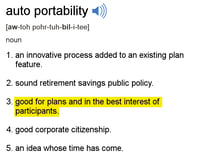 In this five-part series, I identify five key reasons why an auto portability program serves the best interests of plan participants.
In this five-part series, I identify five key reasons why an auto portability program serves the best interests of plan participants. Previously:
- In Part 1, I examined the dramatically improved participant outcomes that will result from a program of auto portability.
- In Part 2, I described how auto portability, by enhancing and extending automatic rollover programs, represents an enhanced standard of participant care.
- In Part 3, I presented evidence that the adoption of auto portability could lead to a reduction in plan expenses.
In Part 4, I address how auto portability could enhance 401(k) participants’ financial wellness.
“Financial wellness” refers to the overall financial health of an individual, as measured by their ability to achieve a healthy balance between their short-term and long-term financial needs, including preparation for retirement. In their 10th Annual Health and Well-Being Survey, published in April, Fidelity Investments and the National Business Group on Health found that “companies across the country are expected to spend an average of $3.6 million on well-being programs in 2019.” According to MassMutual, the trend represents a “financial wellness arms race.”
Auto portability, the automated movement of an inactive participant’s small-balance retirement account from a former employer’s retirement plan to their new employer’s plan, will play a vital role in promoting financial wellness by:
- Preventing unnecessary 401(k) cashouts
- Helping 401(k) participants clear an important retirement savings hurdle
- Simplifying retirement planning
Preventing Unnecessary 401(k) Cashouts
When it comes to 401(k) plans, it’s clear that a large portion of participants are not financially “well” when 40 cents of every retirement dollar saved is lost to cashout leakage.
The real tragedy of these 401(k) cashouts is that almost two-thirds of them are preventable. In 2015, a survey by Boston Research Technologies revealed that only about a third, or 37% of those cashouts were due to a true financial emergency. The same survey also revealed that unnecessary cash outs can lead to significant regret, which grows over time. Research reveals that auto portability would reduce unnecessary 401(k) cashouts by two-thirds.
By addressing the 63% of cashouts NOT due to financial emergencies, auto portability is the perfect complement to short-term budgeting and savings strategies that are standard features of financial wellness programs.
In 2016, Northern Trust’s Sabrina Bailey and Gaobo Pang published The $10,000 Hurdle, a study that documented an empirical pattern of cashout behavior that noticeably dropped as 401(k) participants reached a $10,000+ balance level. Bailey and Pang theorized that crossing the $10,000 level triggers a stronger sense of accomplishment and “incentivizes commitment” – serving to dampen the desire to cash out.
The $10,000 hurdle is particularly important to surpass early in one’s career.According to EBRI tenure data, a typical 25-year old will likely change jobs three times prior to age 34. Based on industry cashout statistics, that same individual will cash out two of their first three 401(k) balances, and at 34, will have preserved only $5,100 in retirement savings.
By contrast, with auto portability, a participant preserving their first three 401(k) balances will cross the $10,000 hurdle by age 31, retaining $16,700 in retirement savings by age 34, which translates into $75,900 at retirement. Perhaps more importantly, they’ll have crossed the $10,000 hurdle early in their career, and as a result, will likely carry forward a much greater sense of financial well-being.
Auto portability, through the process of consolidation, moves small-balance retirement savings forward as participants change jobs. The very simple, yet powerful effect of having one’s retirement savings “all in one place” cannot be overstated.
Consolidation greatly simplifies retirement planning and saves participants both time and money, and when the day finally arrives to retire, consolidation eases the transition to retirement income.
